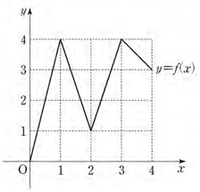Christmas Streak 59/88: 2018 CSAT (Korean SAT) #21 of Liberal Arts

As shown on the right, the graph of , a function defined in the interval , is equivalent to sequentially connecting the points , , , , each with a straight line segment.
How many sets are there that satisfy the below condition?
There exists a function where and and
This problem is a part of <Christmas Streak 2017> series .
This section requires Javascript.
You are seeing this because something didn't load right. We suggest you, (a) try
refreshing the page, (b) enabling javascript if it is disabled on your browser and,
finally, (c)
loading the
non-javascript version of this page
. We're sorry about the hassle.
Since g ( x ) = f ( f ( x ) ) and g ( x ) = f ( x ) , we know that f ( x ) = f ( f ( x ) ) for x = a , b .
If f ( a ) = a , then f ( b ) = a , b . If f ( b ) = b , then f ( a ) = a , b .
But if f ( a ) = b , then f ( b ) = b . . If f ( b ) = a , then f ( a ) = a .
From this we notice that there are two cases:
i ) f ( a ) = a , f ( b ) = b
Then the number of sets X is equivalent to the number of methods of choosing two points from the four intersections of y = f ( x ) and y = x .
4 C 2 = 6 .
i i ) f ( a ) = f ( b ) = a or f ( a ) = f ( b ) = b
Let the four intersections of y = f ( x ) and y = x be A 0 , B 0 , C 0 , D 0 .
Then draw lines perpendicular to the y -axis from each point and find the intersections between each of them and the graph of y = f ( x ) .
Let A = { A 0 , A 1 , A 2 , A 3 } , B = { B 0 , B 1 , B 2 } , C = { C 0 , C 1 , C 2 } , D = { D 0 } be the sets of equal y -coordinates of those intersections.
Pick one of those sets, and choose two among the elements.
But since at least one of ( a , g ( a ) ) and ( b , g ( b ) ) must be on y = x , we must pick the first element of the set.
Therefore there are 3 + 2 + 2 + 0 = 7 ways of doing this.
From above, the total number of cases is 6 + 7 = 1 3 .
(Sorry for the crap explanation.)